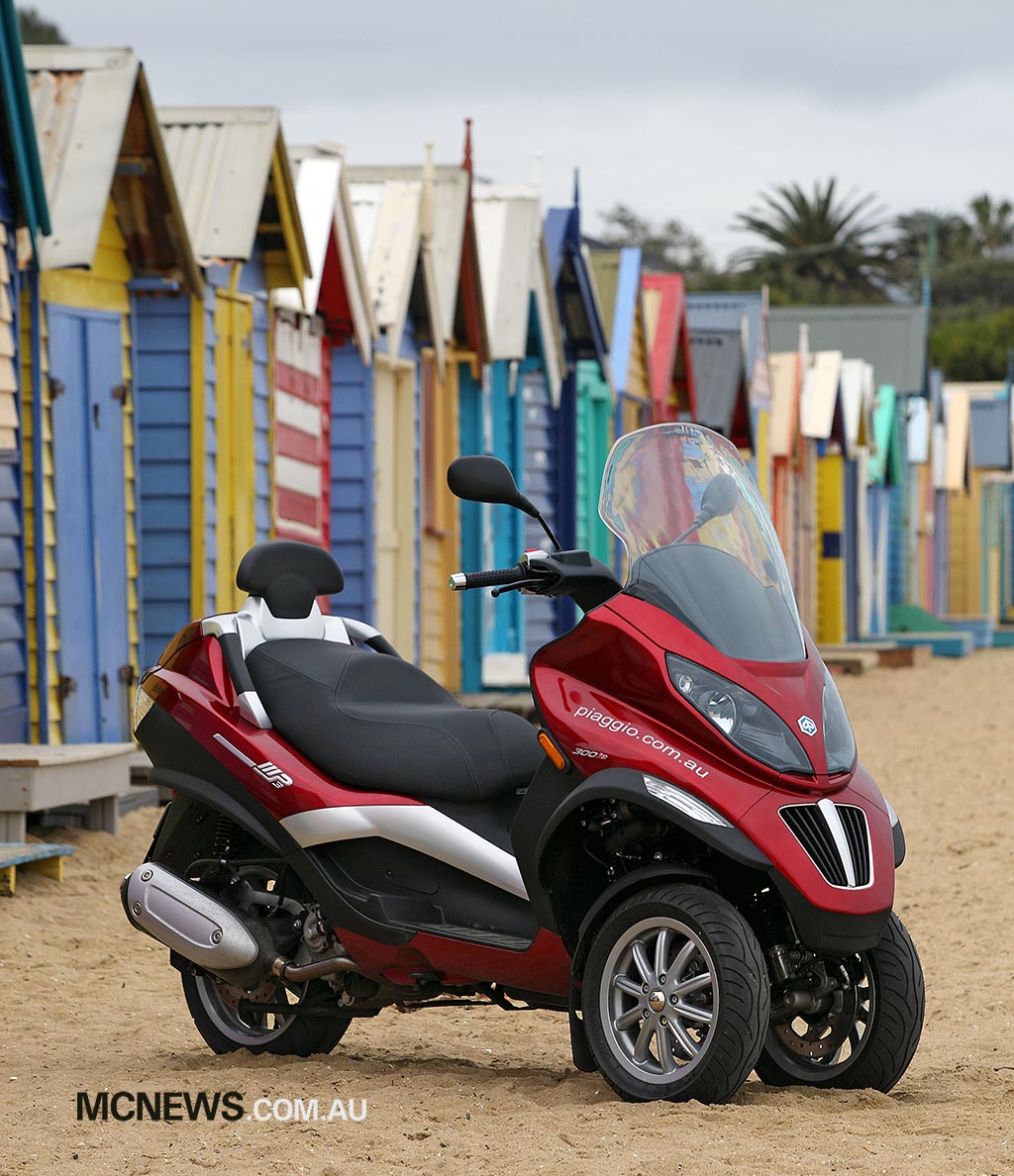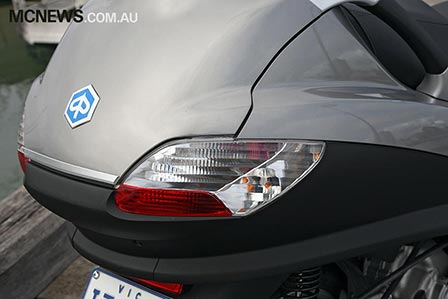Riding the Piaggio MP3 300
By Trevor Hedge
There have been numerous attempts at reinventing the wheel in regards to developments in motorcycle chassis design. Most have ended up as nothing more than engineering oddities quickly discarded by the mainstream. Bucking the established trend has rarely borne fruit but in scooters a new way forward has been firmly established by Piaggio with their intriguing MP3 range of three-wheeled scooters.
If it has three wheels it’s a trike and not a scooter or motorcycle, you say?
And in most instances I would agree as a third wheel generally stops the machine from leaning, and with no lean angle a motorcycle is no longer a motorcycle. Can-Am is putting the case for their Spyder to the public but it does not lean and thus will always remain more akin to an open-wheeler, open-top sports car than a motorcycle. The only thing the Spyder has in common with a motorcycle is that you get wet when it rains.
What Piaggio has done is infinitely cleverer, more fun and remains essentially true to the spirit of motorcycling.
This three-wheeler leans and handles just like a conventional motorcycle or scooter due to the smart way the third wheel is implemented. It brings advantages that add to, rather than detract from, the fun factor that all motorcycle and scooters have in common.
The extra grip on corner entry afforded by the additional front tyre renders slippery surfaces like tram tracks and the like much less problematic. The rear is still prone to sliding but the rear tyre breaking away is generally no problem, as long as the front sticks the scooter remains upright and tracks around the corner. And stick the front does! Truly ridiculous entry speeds to roundabouts and tight corners can be achieved on the MP3. Likewise bumpy surfaces that can make life very painful on most scooters are shrugged off well by the MP3, and the MP3 generates 40-degree lean angles with ease.
Upon testing the first generation of the machine three years ago I stated that never before had I wanted to crash a machine so much. The level of grip at the front of the machine seems almost limitless and I wanted to find that limit and step over it, however, my testicular fortitude ran out before the MP3 ran out of grip. When subjected to ham-fisted stupidity in the form of journalistic scientific investigation the front does eventually slide but even then it just understeers before grip eventually comes back and the MP3 continues around the corner.
It is perhaps this heightened level of grip that has seen Piaggio keep the MP3 devoid of electronic safety aids such as ABS, stability or traction controls. This does mean the MP3 proves epic fun for the experienced rider but as a learner legal machine the fitment of such safety aids is a little remiss. Thankfully the braking power of the MP3 is quite massive and even when the front locks up the machine remains upright thanks to the parallelogram front end. The back brake is also quite powerful but locks prematurely. Clearly the MP3 would benefit from ABS regardless of the security afforded by the layout.
So instead of the third wheel inhibiting the fun of motorcycling, Piaggio’s innovative approach actually manages to up the fun factor while also adding convenient amenity.
A push button on the bar locks the suspension in position from leaning so when parking you simply stop, hit the button and the machine remains upright, no need to kick a sidestand. You can even park on steep slopes as the suspension can simply be locked at any desired angle to facilitate surefooted parking in almost any scenario.
Once you have mastered the art it is simple to activate the lock while rolling to a stop at traffic lights, negating the need for you to put a foot down. The system automatically unlocks as you throttle on from a standstill and resumes normal operation.
Why is it that only Europeans come up with systems that add useful convenience without detracting from the riding experience? Seriously, the Japanese companies really do need to start thinking outside the square a little more when it comes to the functional implementation of technology.
When first released three years ago, Piaggio offered 250cc and 400cc variants in Australia. The Piaggio Group also used their Gilera brand to introduce a more sporting and aggressive variant on the MP3 design with the 500cc Gilera Fuoco. The MP3 250 has now been dropped from the range and replaced by a newly released 278cc version of the machine dubbed the MP3 300.
The new entry level MP3 300 sports larger diameter rims than its predecessor for greater stability and tyre life. While the slightly larger engine is not appreciably more powerful than the 250 it does boast more torque which makes freeway motoring a more pleasant task. It is a little sluggish from a standstill but from 20km/h to 80km/h the MP3 300 accelerates smartly. At 100km/h the MP3 300 is cruising comfortably with the tachometer needle hovering around 6500rpm and has enough urge in reserve to make highway overtaking a possibility.
While 17kg heavier than the outgoing 250 model, the 300 does have a 23kg advantage over the larger MP3 400 and also enjoys a considerable 25% better economy record than the 400. The MP3 300 easily achieves 4 litres per 100 kilometres while the MP3 400 consumes a litre more for each 100km.
The seat on the MP3 300 proves accommodating for short hops but after an hour in the saddle it was starting to become a little uncomfortable. The padding seems a little too soft for the long haul.
65 litres of under-seat storage can be accessed via a handy hatch at the rear of the machine or by raising the seat. Both options are unlatched via convenient facia mounted buttons so there is no fumbling for keys or levers. The storage is long, rather than deep, and thus my Shoei helmet would not fit under the seat although open face helmets most likely would stow away nicely.
Overall the MP3 mounts a compelling argument in its favour as a logical choice for city commuting. There are no significant drawbacks to the twin tyre front end apart from requiring marginally more parking space and even that is offset by the convenience of being able to park the MP3 on any angle thanks to the lockable suspension. Despite the twin tyre front stance the MP3 remains virtually as slim as a comparable capacity scooter and has no problems lane-splitting to the front of the traffic lights, as is perfectly legal to do so in some states.
This motorcyclist is comprehensively convinced by the amenity that the extra front wheel adds to the MP3. Low powered machines require more front end grip than rear grip and the MP3 has this in spades. I would not hesitate to choose the MP3 over a conventional scooter. It’s a winner.


Specs – Piaggio MP3 300
Engine – 278cc, liquid cooled, single-cylinder
Bore x Stroke – 75 x 63mm
Transmission – CVT, twist and go
Seat Height – 780mm
Wet Weight – 236kg
Fuel Capacity – 12 Litres
Average Consumption on test – 4 litres per 100km
Range – 300km
Warranty – Two years
Price – Expect to pay around $9,990 plus applicable stamp duties and registration charges
Positives
+ Fun Factor
+ Convenience
Negatives
– No ABS
– No ASC
– Piaggio MP3 Pictorial























